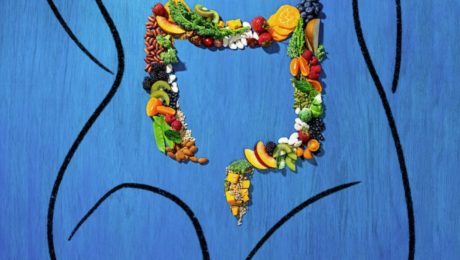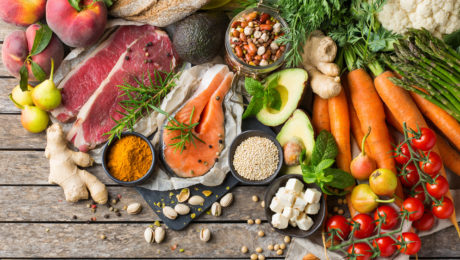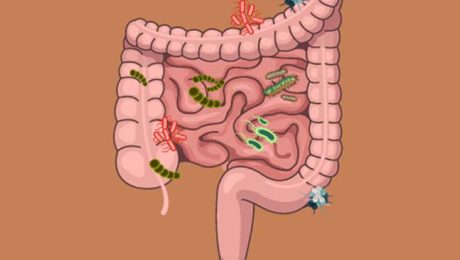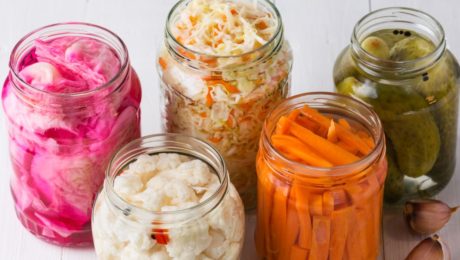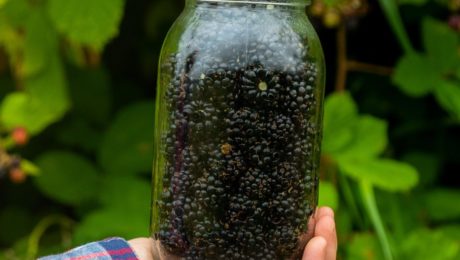10 Year Old Ferment Brand Shuts Down
After 10 years in business, DC-based ferment shop Number 1 Sons has closed, victim to one of the hardships for many small food producers: operation woes.
Number 1 Sons exclusively sold at farmers markets. Their seasonal ferments ranged from pickles, sauerkraut, kimchi, kombucha and vinegar.
They were one of the early adopters of home delivery when the pandemic hit, investing in six refrigeration vans and making over 30,000 home deliveries in 2020 and 2021. In 2022, they returned to selling at farmers markets. But owners and siblings Yi Wah and Caitlin Roberts said in a statement that they can no longer operate in their current space.
“Since 2012, we’ve made pickled and fermented food and drink that we’ve brought to our neighbors at farmers’ markets across the Washington DC area,” they said. “In the spring of 2020, we transformed overnight from a farmers market pickle company into a pandemic grocery delivery business. Such a business transformation is only possible with incredible community or massive resources. Guess which one we had? Our customers trusted us.”
In a statement, Wah and Roberts said: “many businesses are facing rising costs and an increasingly challenging business environment – we recognize our fellow food businesses that are continuing to evolve, innovate, and grind it out. Local independent businesses are key fibers in the community tapestry.”
“We are thankful, and in awe, of our customers, crew, fellow market businesses, and partners (microbes too!) who have been a part of this salty little thing. It’s been a gift to do this with you.”
Read more (Washingtonian)
- Published in Business
Nourishing Microbiota With Fermented Foods
The gut microbiome and how fermented foods can nourish it topped the Washington Post headlines in September. The article shared highlights from the growing number of studies that suggest “these vast communities of microbes are the gateway to your health and well-being — and that one of the simplest and most powerful ways to shape and nurture them is through your diet.” Food (and environment and lifestyle behaviors) have a much larger impact on the gut microbiome than genetics.
The article by health reporter Anahad O’Conner says science proves diverse diets make diverse gut microbiomes. Lower rates of microbiome diversity is linked to chronic diseases like obesity, diabetes and rheumatoid arthritis.
One way to increase that diversity is by eating fermented foods – the article points out yogurt, kimchi, sauerkraut, kombucha and kefir as excellent examples.
“The microbes in fermented foods, known as probiotics, produce vitamins, hormones and other nutrients. When you consume them, they can increase your gut microbiome diversity and boost your immune health, said Maria Marco, a professor of food science and technology who studies microbes and gut health at the University of California, Davis.”
A study by researchers at Stanford – and published last year in the journal Cell – found people who eat fermented food regularly increase their gut microbial diversity and lower their levels of inflammation.
“While it’s clear that eating lots of fiber is good for your microbiome, research shows that eating the wrong foods can tip the balance in your gut in favor of disease-promoting microbes,” writes O’Connor. The “bad” microbes, according to research, are commonly found in highly processed foods “that are low in fiber and high in additives such as sugar, salt and artificial ingredients. This includes soft drinks, white bread and white pasta, processed meats and packaged snacks like cookies, candy bars and potato chips.
Tim Spector, professor of epidemiology at King’s College London and the founder of the British Gut Project, tells the Washington Post that eating a wide variety of plants, fiber and nutrient-dense foods is also beneficial for the gut. Spector encourages people to eat 30 different plant foods a week, which can include produce, nuts, herbs and spices.
Read more (The Washington Post)
Endangered Fermented Foods
Through selective breeding and domestication of plants and livestock, the world’s food system has lost diversity to an alarming degree. Crops are monocultures and animals are single species. Journalist and author Dan Saladino argues it’s vital to the health of humanity and our planet to save these traditional foods.
“There’s an incredible amount of homogenization taking place in the last century, which has resulted in a huge amount of concentration of power in the food system but also a decline in the amount of biodiversity,” says Saladino, author of Eating to Extinction. “That agricultural and biological diversity is disappearing and it’s taken us thousands, millions of years for plant, animal evolution to get to this point.”
Saladino was a keynote speaker at The Fermentation Association’s conference FERMENTATION 2022, his first in-person talk in the United States since his book was released in February. A journalist with the BBC, Saladino was also an active participant in the event, attending multiple days’ worth of educational sessions. He called the conference “mind expanding.”
“I thought I knew about fermentation, when in fact I know very little,” Saladino said to the crowd in his keynote. “We’ve been bemused by the media reports that fermentation is a fad or fashion. What we know is that the modern food system in the last 150 years is the fad. It’s barely a blip in the context of our evolution as species, and it’s the way we’ve survived as a species over thousands of years.”
Eating to Extinction includes 40 stories of endangered foods and beverages, just touching on a fraction of what is happening around the world. To date, over 5,000 endangered items from 130 different countries have been cataloged by the Slow Food Foundation’s project the Ark of Taste.
During FERMENTATION 2022, Saladino centered his remarks around the endangered fermented foods he chronicled in his book – Salers cheese, skerpikjøt, oca, O-Higu soybeans, lambic beer, pu’erh tea, qvevri wine, perry and wild forest coffee. Here are some of the highlights of his presentation.
Salers cheese (Augergne, Central France)
Fermentation was a survival strategy for many early humans, a fact especially evident in the origins of cheesemaking. In areas like Salers in central France, villagers live in inhospitable mountain areas where it’s difficult to access food. In the spring each year, cheesemakers travel up the mountains with their cattle and live like nomads for months.
“It’s extremely laborious, hard work,” Saladino says, noting there’s only a handful of Salers cheese producers left in France. He marvels at “the ingenuity of taking animals up and out to pasture in places where the energy from the sun and from the soil is creating pastures with grasses with wildflowers and herbs and so on.”
Unlike with modern cheese, no starter cultures are used to make Salers cheese. The microbial activity is provided by the environment – the pasture, the animals and even the leftover lactic acid bacteria in the milk barrels. Because of diversity, the taste is rarely consistent, ranging season to season from mild to aggressive.
“The idea of cheesemaking is a way humans expand and explore these new territories assisted by the crucial characters in this: the microbes,” he adds. “It can be argued that cheese is one of most beautiful ways to capture the landscape of food – the microbial activity in grasses, the interaction of breeds of animals that are adapted to the landscape. It’s creating something unique to that place.”
Skerpikjøt (Faroe Islands)
Skerpikjøt “is a powerful illustration to our relationship with animals, with meat eating,” Saladino says. It is fermented mutton and unique to Denmark’s Faroe Islands. Today’s farmers selectively breed their sheep for ideal wool production, then slaughter the lambs for meat. In the Faroes, “the idea of eating lamb was a relatively new concept.” Sheep are considered vital to the farm as long as they’re still producing wool and milk.
Once a sheep dies or is killed, the mutton carcass is air-dried and fermented in a shed for 9-18 months. The resulting product is “said to be anything between Parmesan and death. It certainly has got a challenging, funky fragrance,” Saldino says.
But it contrasts traditional and modern food practices. Skerpikjøt is meant to be consumed in small quantities, delicate slivers of animal proteins used as a garnish. Contemporary meat is served in large portions and meant to be consumed quickly.
Oca (Andes, Bolivia),
In the Andes – “one of the highest, coldest and toughest places on Earth to live” – humans have relied on wild plants like oca, a tuber. After oca is harvested, it’s taken to the Pelechuco River. Holes are dug on the riverbank, then filled with water, hay and muna (Andean mint). Sacks of oca are placed in the holes, weighted down by stones, and left to ferment for a month. This process is vital as it leaches out acid.
“Through processing, this becomes an amazing food,” Saladino says.
But cities are demanding certain types of potatoes, encouraging remote villagers to plant monocultures of potatoes which are prone to diseases. The farmers end up in debt, buying fertilizers and pesticides to grow potatoes.
“For thousands of years, oca and this fermentation technique and the process to make these hockey pucks of carbohydrates and energy kept them alive in that area,” Saladino says. “It’s a diversity that is fast disappearing from the Andes.”
O-Higu soybeans (Okinawa, Japan)
The modern food industry is threatening the O-Higu soybean, too. It was an ideal soybean species – fast-growing, so it can be harvested before the rainy season and the arrival of insects.
“But by the 20th century, the soy culture pretty much disappeared,” Saladino says.
With World War II came one of America’s biggest military bases to Japan. U.S. leaders dictated what food could be planted on the island. Okinawa was self-sufficient in local soy until American soy was introduced.
Lambic Beer (Belgium)
Saldino explained that, after a spring/summer harvest, Belgian farmers became brewers. They used their leftover wheat to create brews unique to the region.
But by the 1950s and 1960s, larger brewers began buying up the smaller ones. Anheuser-Busch InBev now produces one in four beers drunk around the world.
“There [is] story after story of these distinctive, unique, small breweries disappearing as they are bought up or absorbed into this growing, expanding empire of brewing,” Saladino says. “It’s probably one of the most striking cases of corporate consolidation of a drink and food product.”
Saladino stressed not all is lost. He shared stories of scientists, researchers and local people trying to save endangered foods, collecting seeds, restoring crops and combining traditional and modern-day practices to preserve the world’s rare foods.
“There have been so many fascinating stories of science and research discussed over the last few days at this conference, and I think the existence of The Fermentation Association is exciting because it is bringing together tradition, culture, science, culinary skills, all of these things we know food is,” Saladino added. “Food is economics, politics, geography, anthropology, nutrition. What I’m arguing is that these clues or glimpses into the past for these endangered foods, they’re not just some kind of a food museum or an online catalog. They are the solutions that can help us resolve some of the biggest food challenges we have.”
- Published in Food & Flavor
Dietitians Say: Nordic Diet Healthiest Option
The Nordic Diet is getting more attention from dietitians, who are encouraging clients to embrace a range of fruits, vegetables, fish and fermented food and drink.
“’The Nordic diet features a large variety of foods, without any strict restrictions, which are key to a sustainable way of eating,” says Tamara Willner, London-based nutritionist.
Though the Mediterranean diet has dominated dietitians’ wellness advice, the Nordic diet is a heartier option. It includes seasonal foods that thrive in colder climates, like root vegetables – beets, carrots, turnips – and fruits – plums, apples and berries. Fish like herring are also recommended. Fermented food is a key differentiator between the two diets – kefir, fermented fish and fermented vegetables are prominent in Nordic countries.
“Our gut hosts a huge number of gut microbes that feed off the foods we eat and produce more bacteria,” Willner continues.
The Nordic diet is cheaper to maintain, too. The produce is generally less expensive and the Nordic diet relies on whole grains, beans or lentils.
Read more (Daily Mail)
- Published in Food & Flavor
The Microbiome “Black Box”
The gut microbiome is the “black box” of nutrition research, according to the new study “Rethinking Healthy Eating in Light of the Gut Microbiome.” We will never fully understand the science behind nutrition without understanding the bacteria living in the gut.
“Given the worldwide epidemic of diet-related chronic diseases, evidence-based dietary recommendations are fundamentally important for health promotion,” reads the study. “Despite the importance of the human gut microbiota for the physiological effects of diet and chronic disease etiology, national dietary guidelines around the world are just beginning to capitalize on scientific breakthroughs in the microbiome field.”
The study, published in the journal Cell, Host & Microbe, was conducted by researchers and scientists from Canada’s Department of Agriculture, Food & Nutritional Science; Ireland’s University of College Cork Centre for Vitamin D and Nutrition Research; and the APC Microbiome Ireland. It discusses “contemporary nutritional recommendations from a microbiome science perspective, focusing on mechanistic evidence that established host-microbe interactions as mediators of the physiological effects of diet.”
Though research on the microbiome and gut health has increased in the last decade, “there has been limited consideration of diet-microbiome-host interactions.” Researchers propose an “experimental framework that integrates the microbiome into nutrition research.”
Below are some of the challenges researchers found in creating a microbiome-focused diet.
More Fermented Food Research
Fermented foods are an excellent approach for microbiome restoration, the study notes. In individuals who have a diet rich in fermented foods, the organisms from the fermented foods are well-represented in their microbiota.
But more research is needed on fermented foods – especially non-dairy ones. Published studies link fermented foods to more favorable gastrointestinal health, lower risk of type 2 diabetes and cancer, increased microbiome diversity and weight management.
“Evidence from random control trials is extremely sparse, and fermented foods are just beginning to be recommended in dietary guidelines,” the study notes.
Lacking Dietary Guidelines
The study details different countries’ food recommendations and healthy eating guidelines in relation to the gut microbiome. Interestingly, though the regions have diverse food cultures, similarities were found: vegetables, fruit and grains should make up half a diet; whole grains should be prioritized over refined grains; animal protein and plant-based proteins should be consumed in small portions; foods high in sugar, salt and saturated fat should be limited or avoided.
But only one country – South Africa – mentions the gut microbiome.
Personalized Nutrition
Still, dietary guidelines are not a one-size-fits-all approach. There’s a greater need for personalized nutrition (also referred to as precision nutrition) because the gut microbiota is highly individualized. National dietary guidelines currently do not consider personalized nutrition.
As technology improves and microbiome sequencing increases, it’s possible a smart phone app could help the public monitor their diets, with recommendations personalized to their needs.
“Precision-nutrition approaches will depend on continued collaboration between nutrition and microbiome disciplines, and their population-wide implementation will require significant additional input from regulatory bodies, professional societies, and policymakers,” the study says.
Unknowns of Fermented Plant-Based Protein
There are “promising findings” regarding plant-based proteins’ interaction with the microbiome. Because these products are less digestible than animal-based proteins, they produce beneficial metabolites in the gut. However, the study points out more research is needed into these fermented alternative proteins that are fueling current innovation in alt meats.
Ancestral vs. Industrialized Diets
Modern diets – also known as industrialized diets – are far from those of our hunter-gatherer ancestors. Ancestral diets included more plants, higher dietary fiber and fewer refined carbs and sugar. The chronic disease epidemic, researchers note, can be attributed to modern diets being “evolutionarily mismatched with human physiology.”
“Evolutionary considerations also lay the foundation for microbiome restoration strategies,” the study continues. “Although it will likely be impossible, and perhaps not advisable, to return microbiomes to their ancestral states, there is heightened interest in the development of microbiome restoration strategies that re-establish health-related functional characteristics.
What Is or Isn’t a Health Claim?
What exactly constitutes a health claim on a food label? It’s a contentious topic that can be a source of problems and expenses for the unwitting producer.
“We want to communicate accurately and effectively to consumers in a way that’s truthful and not misleading. There needs to be a body of evidence that supports health claims,” said Josephine Wee, PhD, an assistant professor of food science at Penn State (and member of TFA’s Science Advisors). “The bottom line: health claims are complicated.”
Wee unpacked what is and isn’t a health claim during the FERMENTATION 2021 conference. Similar topics into the regulation of fermented foods will be addressed at TFA’s August conference, FERMENTATION 2022.
Wee questioned: does the fermentation community require health claims on certain fermented foods? Today, terms like gut health, probiotics and improved immunity dominate the language of fermented foods. But words and definitions matter, Wee stressed.
Defining Health Claims
When putting health claims on a food label, website or marketing material, information must be truthful and transparent. Remember:
– The FDA has approved only 12 health claims. In the U.S., food labels can legally only include health claims that meet FDA requirements. There must be “significant scientific agreement among qualified experts that these claims are factual and truthful,” Wee said. FDA approval is based on the amount of publicly available, scientific evidence from reputable studies.
– A health claim is not a nutrient claim. Food producers cannot link the effect of a nutrient or food to a disease or health condition (other than in the rare case that there is supporting scientific evidence). Nutrient claims are defined by the FDA to “describe the level of a nutrient in the product, using terms such as free, high, and low, or they compare the level of a nutrient in a food to that of another food, using terms such as more, reduced, and lite.”
– A health benefit cannot be used interchangeably with a health claim. A health claim must pass a two-part test: first, contain the characterization of the type of food/food component and, second, state its relationship to a disease. For example: “A good source of calcium and vitamin D. Reduces risk of osteoporosis.”
“The reason for these standards is that it provides a high level of confidence to validate the substance and disease relationship,” Wee said.
What is Not a Health Claim?
Wee said producers must be careful not to mislead consumers with an inaccurate health claim.
She shared the International Scientific Association for Probiotics and Prebiotics (ISAPP) consensus statement on fermented foods. In it, the authors write: “Although consumers have become increasingly interested in fermented foods, it is unfortunate that, in our opinion, much information available on fermented foods in popular press magazines, websites and social media is exaggerated or inaccurate.”
Here are four health-related claims that are not health claims.
1. Description of well-being from consumption of a food. These claims do not mention a disease or disease-related condition. For example, “Multivitamins contribute to general good health.”
2. Structure-function claims. A structure-function claim describes the role of an ingredient in affecting or maintaining normal structure or function in humans. “There is this presence of this food and food ingredient, but it doesn’t really talk about disease,” Wee explained. For example, “Calcium builds strong bones.”
3. Dietary guidance. A dietary label addresses the role of good health in general dietary patterns. For example, “Five servings of fruits and vegetables a day are recommended for good health.”
4. Nutrient content claim. These characterize the level of nutrients in food. For example, “Good source of fiber.”
“These four health-related claims are sometimes mistaken for health claims,” Wee said, “but they’re actually not health claims by the definition of regulatory agencies such as the FDA.”
Where Can Producers Get Into Trouble?
Securing FDA approval for a new health claim can be arduous. Under the Nutrition Labeling Education Act of 1990 (NLEA), a company can petition the FDA to consider a new health claim. But the process is typically lengthy (240-540 days) and costly.
Often, it is a competitor that challenges a producer’s health claim.In 2010, Dannon was ordered to pay $45 million in a class-action lawsuit brought against them by Activia yogurt. Dannon’s ads claimed their yogurt was clinically and scientifically proven to regulate digestion and boost immune systems, but were deemed to be false advertising.
In the past few years, kombucha brands have been particularly vigilant in monitoring health claims in their industry. Tortilla Factory (parent of Kombucha Dog) sued Trader Joe’s, Better Booch, Makana Beverages and Rowdy Mermaid Kombucha for supposedly violating the law by exceeding the 0.5% abv threshold.
“I think as fermented foods become more mainstream…over time consumers will become more educated and understand what these labels mean,” Wee noted.
- Published in Business
The “Tip of the Iceberg” of Fermented Foods
There’s a huge amount scientists worldwide still need to learn about fermented foods. “We’re really at the tip of the iceberg, as far as I’m concerned,” says Paul Cotter, professor and head of Biosciences at Teagasc Ireland.
“If you think of the vast variety of fermented foods from all across the globe – from East Asia, from Africa, from South America – we really haven’t studied these in any great degree at all, maybe some very basic study, but no microbiome analysis,” Cotter continues. “So really not fully appreciating what’s in there or really harnessing those foods for broader society.”
Cotter, Bruno Pot (science director at Yakult Europe) and Maciej Krol (founder of mac.ferments) discussed fermented foods at a panel at this year’s Probiota conference in Copenhagen. In an interview with NutraIngredients – which wrote “fermented foods took center stage” at the conference – Cotter and Pot discussed the opportunities and challenges of fermented foods.
Expanding the Study of Fermented Foods
Modern technology continues to advance, allowing DNA sequencing and complex analysis of food. It’s of “critical importance” that we further study fermented foods, Cotter adds.
For example, there have been numerous randomized controlled trials with dairy kefir that confirm health benefits. But the results were shown to be dependent on the probiotic strains used – one could help reduce cholesterol, while another would address the gut-brain axis.
“If you don’t happen to have the right one in your kitchen, you’re not benefiting from it,” he says. “By carrying out in-depth investigations of the microbiomes and the metabolites that they produce, you can get a better sense as to what foods have the right microbes for you and to make almost a personalized type of fermented food for each person.”
Cotter stresses studying the foods individually rather than fermentation as a whole. There are specific foods, unique to a country or culture and produced on a small scale, “that we know very little about and might have fantastic health attributes.” He fears that, if these foods aren’t studied, the populations that traditionally make them will die off or move, and their approaches to making these foods will be lost.
Dietary Microbes
Pot points to the fact that non-communicable – “New Age” – diseases emerged and began to increase as food production became more commercialized.
“We need to promote (the) intake of live microorganisms,” Pot says. The public needs to be told “how important it is to maintain healthy conditions in their gut.”
Pot is pushing for a microbes category to be included in dietary recommendations. A late 2020 study published in The Journal of Nutrition officially introduced the idea that a daily intake of microbes could improve health. He compares it to the definition of dietary, which helps educate the public about the kinds of fiber important in a healthy diet.
“The purpose of creating a category is really to allow easier communication with the consumer about the importance of live microorganisms in the diet,” Pot says. “The creation of this category will be a first step.”
Any recommendations, he adds, must be based in science. But it can be challenging to try to educate consumers about often complex scientific topics. It’s important for messaging to be simple, Cotter adds.
“Unless you have a means of explaining to the consumer what are these benefits, then you’re running into great difficulty,” he says.
Today, the public is more conscious today of immune health, and views fermented foods as natural and functional. Cotter believes, if it can be scientifically proven that dietary microbes should be consumed daily, legislators and regulators will add it to dietary guidelines.
Artisanal vs. Large Scale
Cotter sees the future of fermented foods tied to compromise between large- and small-scale producers. Industrialized ferments need to be tweaked to more closely resemble artisanal foods, while artisanal products need to become more readily available to the public at large.
“Fermented foods are quite often very healthy, but the health benefits aren’t fully appreciated because they haven’t been studied in great depth,” he says. “Typically, when those foods have been converted to make them on a large scale by an industry for production to try to make a product that’s available to as many people as possible, the microbiology of the food is very much simplified.”
On the other hand, it’s challenging to “harness the health benefits associated with artisanal foods” when a small brand scales up.
“I think there’s an opportunity for the two to meet in the middle,” Cotter says. “Retain artisanal qualities associated with food but make them available to as many people as possible for mass production.”
Fermented Foods and Running
Fermented foods continue to top nutritionists’ lists as a key healthy and functional component in the ideal human diet. In a new article in Runner’s World, a registered dietician recommends runners eat fermented foods to meet nutrition needs, improve their health and better support their training.
The author lists four reasons to eat fermented foods: improve the gut microbiome, add a nutritional upgrade, aid digestion and improve protein intake.
“Recent research even suggests that the makeup of our microbiome may also play a role in how our muscles adapt and develop in response to exercise. And fertilizing your gut with more desirable bacteria via fermented foods may payoff with better digestive functioning during periods of hard training and throughout long races (read: fewer sprints to the nearest port-a-potty),” the article reads. “To date, the literature suggests that probiotic foods (like fermented foods) are still the preferred method of obtaining probiotics rather than relying on supplements.”
Read more (Runner’s World)
- Published in Health
Fermented Blackberry’s Anti-Wrinkle Power
A new study found ingesting fermented blackberries wards off wrinkles, increasing collagen and skin thickness.
Researchers tested the effects on Korean adults – between the ages of 35 and 60 – over a period of 12 weeks . The blackberries – fermented with lactic acid bacteria – were found to significantly decrease wrinkles around the eyes.
The results, published in the journal Cosmetics, are a follow-up to a clinical trial on the formula (known as BB-1000) in mice.
“The significance of this study is that the anti-wrinkle efficacy of a fermented blackberry product was confirmed not only in previous animal experiments but also in this clinical trial.” As a result of clinical trials on skin wrinkle improvement and safety, BB-1000 is expected to be used with confidence as a healthy functional food that can improve skin wrinkles.”
Read more (Molecules)
- Published in Science


